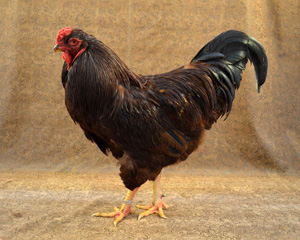Part of our Breed Profiles series, the Buckeye is a dual-purpose bird with gorgeous dark-red plumage.

Buckeye Cockrel. Photo courtesy of The Livestock Conservancy
History
For those of you who know that Ohio is call the Buckeye State after the tree, you won’t be surprised to learn that the Buckeye chicken breed was originally developed by Nettie Metcalf of Warren, Ohio, in 1896. A standard breed recognized by the American Poultry Association (APA), the Buckeye is the only breed to have been developed exclusively by a woman. Metcalf wanted to breed a bird that could withstand the freezing temperatures of Ohio winters, so she crossed Barred Plymouth Rocks, Buff Cochins, and Black-Breasted Red Game birds. The resulting bird was admitted to the APA’s Standard of Perfection in 1904. Buckeyes are a heritage breed that most often appear as part of small farms or urban flocks.
Characteristics
Primary use: Meat and eggs
Temperament: Gentile, active birds
Size: Medium
Annual egg production: 150 to 200
Egg color: Large, brown
Average weight: 5.5 to 8 pounds
Physical Features
Buckeyes are the only breed in the American class with a pea comb. They’re yellow-skinned, dual-purpose birds that lay brown eggs. Hens average 6.5 pounds (2.9 kilograms) while males average 9 pounds (4.1 kilograms). Their feathers are a mahogany red, and they have black-feathered tails, so they can look similar to Rhode Island Reds. Buckeyes have a compact, broad-backed body with tan or slate feathers near the body.
Temperament
Buckeyes are a generally calm breed, though sometimes the cocks can be aggressive in defense of their flock, emitting a wide range of sounds. Despite their game bird heritage, Buckeyes can tolerate being penned, but they have better egg production when they can range on grass.

Buckeye hen. Photo courtesy of Stromberg’s Chicks
Health and Safety
This breed is a generally healthy bird, and processes feed and foraging efficiently.
Further Resources
Carol Ekarius Storey’s Illustrated Guide to Poultry Breeds
Christine Heinrichs How to Raise Chickens
The Livestock Conservancy












